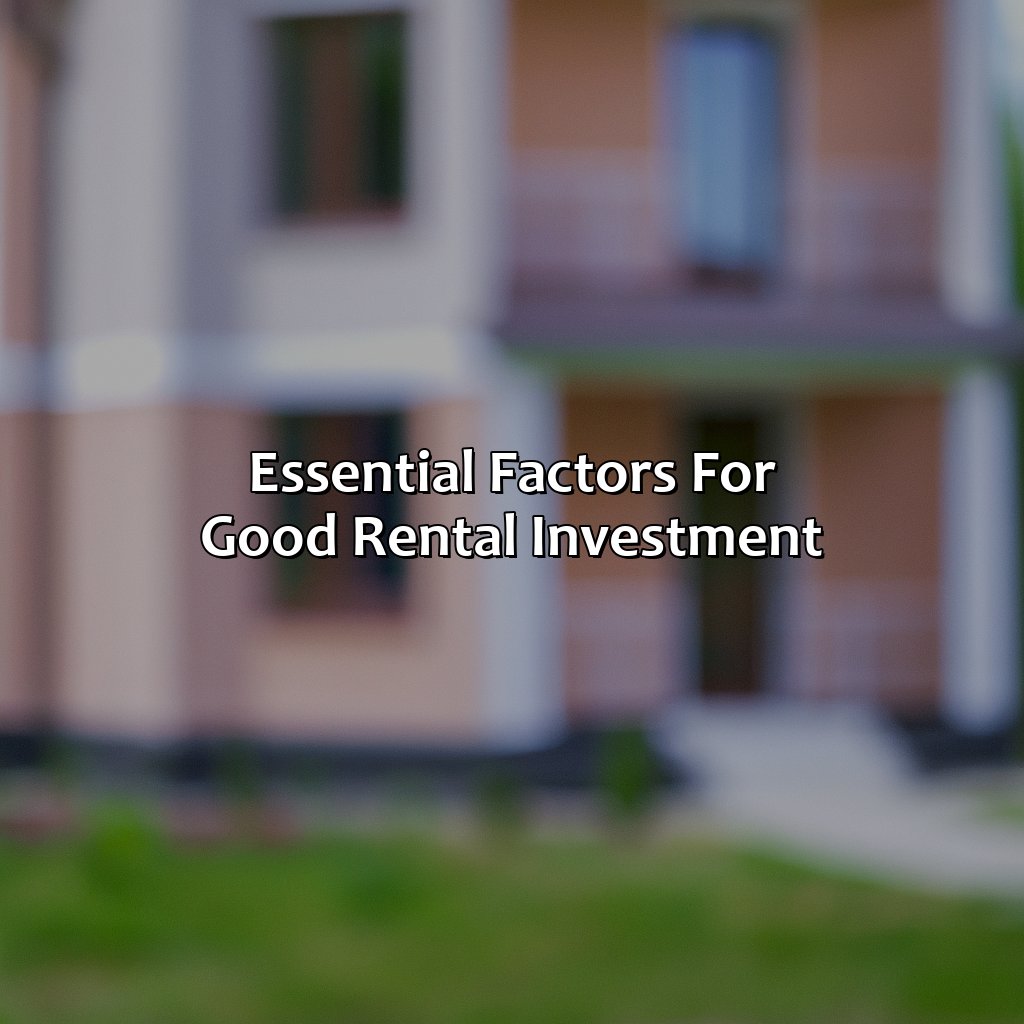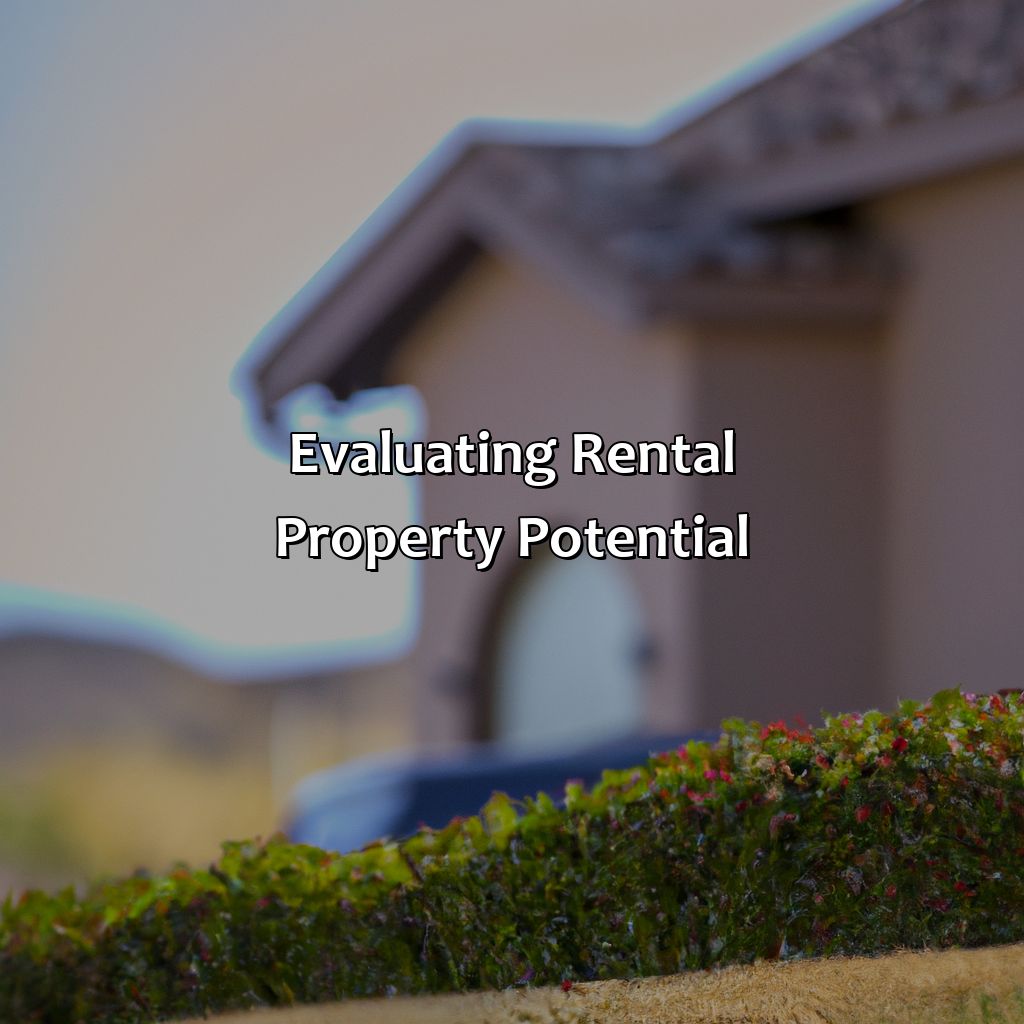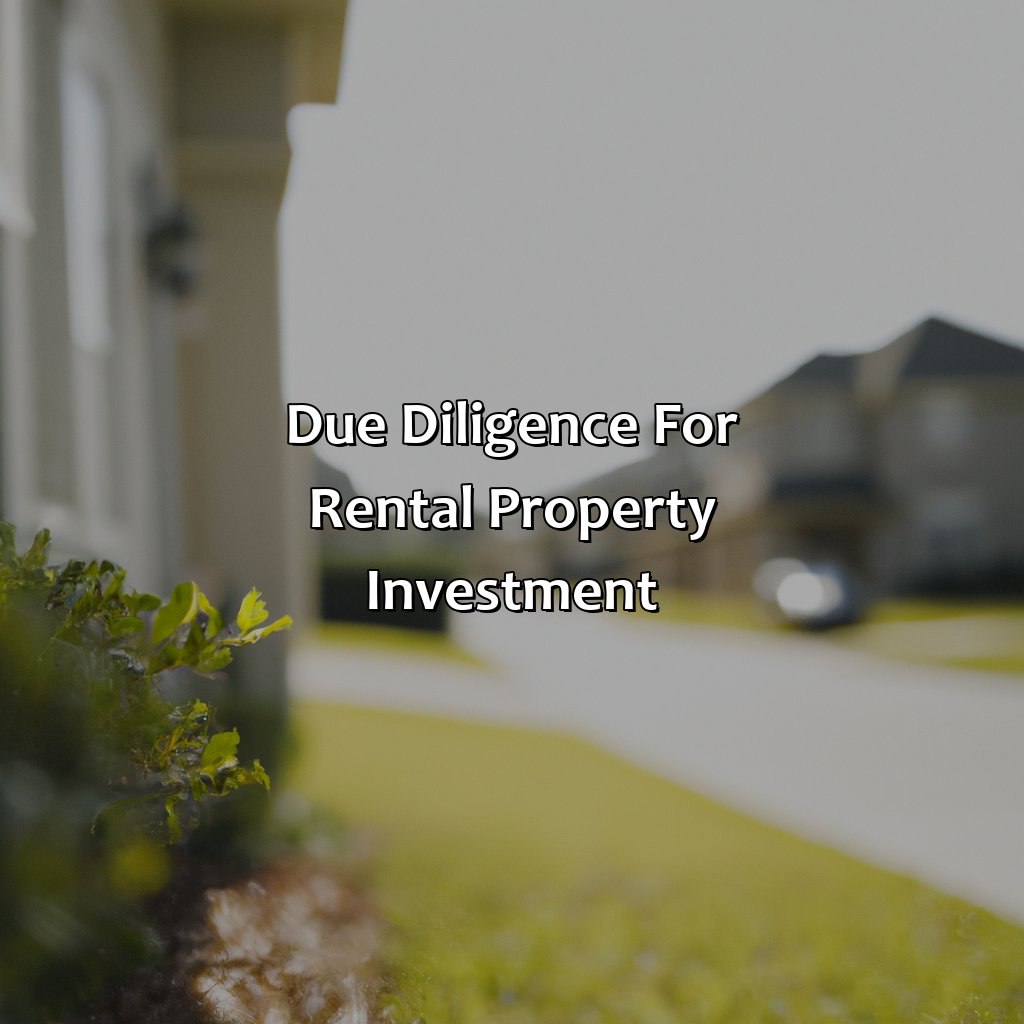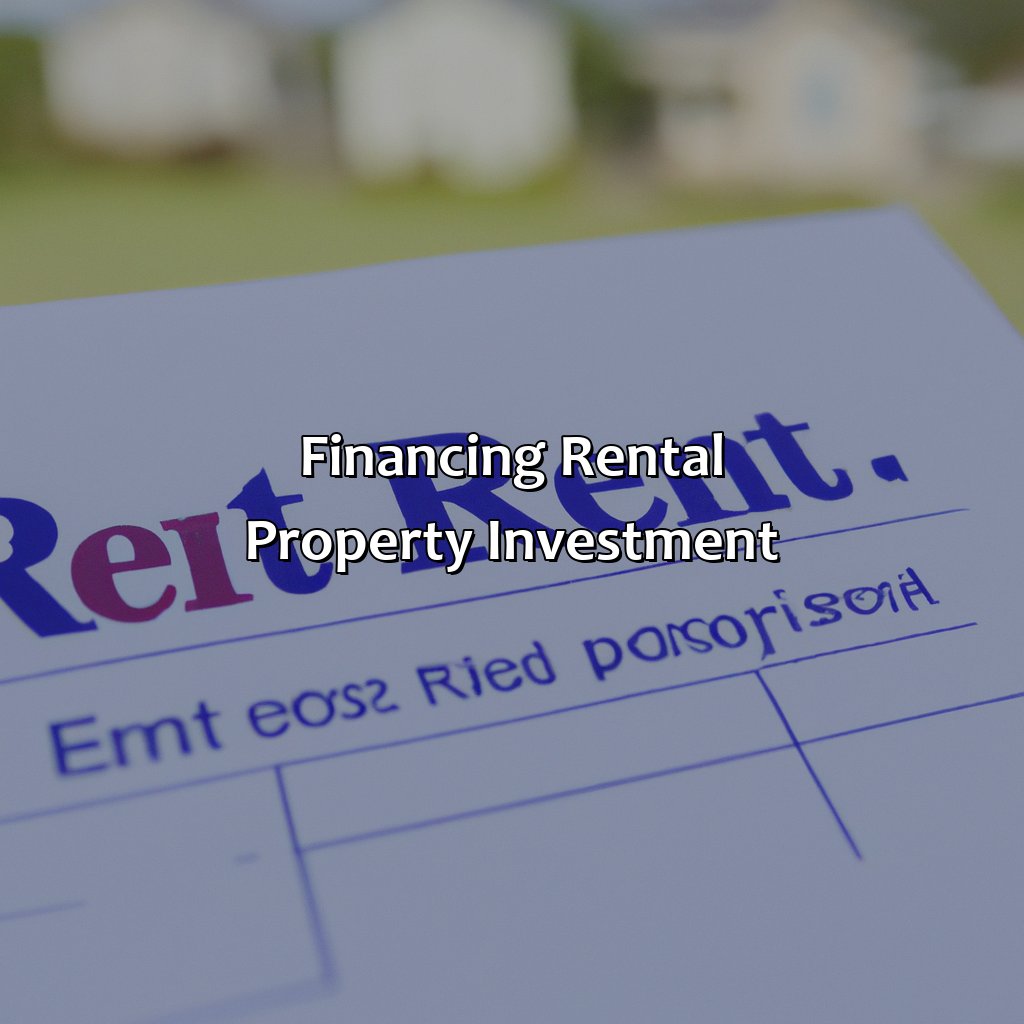How To Know If A Rental Property Is A Good Investment?
Key Takeaway:
- Location is a crucial factor for a good rental investment as it affects the demand for rental properties and market value. Consider factors such as proximity to amenities, public transport, and the local job market.
- Evaluating rental property potential involves analyzing metrics such as cap rate, cash-on-cash return, and net operating income to determine the expected return on investment and cash flow potential.
- Performing due diligence for a rental property investment includes property inspection to identify potential maintenance costs, as well as understanding legal compliance and restrictions that may impact the investment.
- Financing a rental property investment requires careful consideration of down payment and loan options, as well as projections of expected ROI and cash flow. It is also important to understand the tax benefits and implications of rental property ownership.
Are you considering investing in a rental property but unsure of whether it’s a good move? Knowing the key financial and legal considerations can help you make an informed decision. You can make the most of your investment and create a successful rental business with our guide.
Essential Factors for Good Rental Investment
Want guaranteed returns from your rental investment? You gotta know the essential factors. Location, Rent Demand and Market Value, and Tenant Screening Process – these sub-sections of Essential Factors for Good Rental Investment will help you decide if it’s profitable or not.

Image credits: retiregenz.com by David Jones
Location
When it comes to rental property investment, the location plays a pivotal role in determining its success. A rental property’s ideal location should have high demand, accessibility to amenities and public transport, and low crime rates.
Having a rental property in a desirable location ensures consistent occupancy rates and higher rental income. In contrast, investing in a less than optimal location can result in long vacancies or potential damages to the property by unreliable tenants.
Apart from location, proximity to schools, hospitals, shops, restaurants and parks can also contribute positively to your rental investment portfolio.
Investing in a prime location may require you significantly more than areas of lower return – however, consider well-planned layouts from trusted developers who apply globally recommended green building standards as these are likely to see organic appreciation rather than creating artificial increases through massive marketing campaigns.
Consider demographics such as family-friendly neighbourhoods if your target tenant population is families with children. Renting out student housing near universities is another option – this target population is less likely to stay for an extended period yet provides regular turnover with good returns.
Maintaining faith with sustainable urban planning regions could be worthwhile in securing tenants committed not only toward renewable consumption benchmark goals but beholden to their ecological values generating modest ecological gains for you too.
Want a high demand and market value for your rental property? Just make sure it’s not haunted…or located next to a graveyard.
Rent Demand and Market Value
Investing in a rental property involves careful analysis of various factors that ensure good returns on investment. One such crucial factor is gauging the interplay between rent demand and market value. It is essential to ascertain if there is a stable demand for rental properties in a particular geographical location, as well as comparing the market value of the property with its rental income potential.
One cannot accurately establish rental property’s suitability for investment by focusing solely on market value or rent demand in isolation. An investor should research data from multiple sources to assess if the rent charges are competitive and if there is consistent demand for rentals in that area. Additionally, analyzing long-term trends can provide a holistic perspective necessary for making informed decisions.
While analyzing rent demand and market value, it is vital to examine unique features that differentiate the property from others in its class. Amenities like access to public transport, parking facilities make renting out your property more lucrative for potential tenants and provide more options for rental income streams.
History reveals several instances where investing based only on market values resulted in lost opportunities due to negligence regarding rent demand analysis. In contrast, analyzing both market value and rent demand has led to better positioning of investments that garnered substantial returns over time.
Finding the perfect tenant is like finding a needle in a haystack, but it’s worth it to avoid the hay fever of bad tenants.
Tenant Screening Process
The process of scrutinizing a potential tenant is crucial in renting out a property. Proper screening assures the landlord that their property will be occupied by tenants who are reliable and responsible in paying rent, taking care of the property, and causing minimal issues during occupancy. It also ensures that a landlord’s investment will yield positive returns.
When considering prospective tenants, it is important to check for their credit scores, employment history, income statements and previous landlords’ references. Additionally, conducting a criminal background check can help discern potentially problematic tenants. Once screened positively, ensuring that they sign a comprehensive lease agreement with appropriate terms to protect both parties is essential.
Rental properties often suffer from wear and tear overtime thus choosing quality tenants is paramount in preventing foreseeable damages from occurring. Communication between tenant and landlord should be effective to address any concerns from either side.
In the past, landlords would solely rely on basic information like paycheck stubs or bank statements as a measure of trustworthiness when selecting tenants. Nowadays, however, modern systems such as online databases have made it less time consuming to check for past rental behavior or criminal records improving the screening process.
“Finding the perfect rental property is like searching for a needle in a haystack, except the haystack is on fire and the needle is made of gold.”
Evaluating Rental Property Potential
To evaluate rental property potential, use Cap Rate, Cash-on-Cash Return, and Net Operating Income. Sub-sections help you figure out the profitability of the property. Analyze investment cost, return on investment, and operating expenses to make a conclusion.

Image credits: retiregenz.com by Yuval Duncun
Cap Rate
Real Estate Investment Potential Metric
A real estate investor needs to evaluate rental property potential before buying a property. One of the most important metrics used for assessing rental property potential is the Capitalization Rate (Cap Rate). The Cap Rate is an estimate of the proportionate return on investment that an investor can expect from their investment property. It is calculated by dividing the property net operating income by its current market value.
For instance, if a property generates $100k in net operating income and its market value is $1 million, then the Cap Rate would be 10%. This means that investors can expect a return on investment equal to 10% based solely on their property’s operations. Using this metric, investors can assess whether or not they should invest in a particular rental property.
As a unique point, it’s important to mention that Cap Rates vary depending on geographic location and type of real estate sector: commercial or residential properties. Additionally, this metric may not account for all relevant expenses and some risks associated with owning a rental home or communal living buildings.
Interestingly, in times when interest rates fluctuate significantly and financing options are limited, savvy investors tend to pay closer attention to this metric when selecting potentially stable and profitable long-term investments. By contrast, low-lying marginal Cap Rates may indicate weak demand i.e., overpriced properties that aren’t worth investing in.
Calculating cash-on-cash return is like speed dating an investment – you want to know if it’s worth your time and money before committing to a long-term relationship.
Cash-on-Cash Return
Investment Profitability: Analyzing the Potential of a Rental Property is an important aspect to know before making a decision. A valuable metric to consider is Cash-on-Cash Return. It calculates a ratio between the cash flow generated and the total amount of investment used in purchasing the property.
This indicator measures monthly or annual rental profits compared to how much money was invested in owning that property. The calculation includes expenses such as mortgage payments, maintenance costs, insurance fees, property taxes, and other charges. Higher Cash-on-Cash Return indicates better profitability.
Many factors such as location, vacancies, competition influence this return. Investors might analyze these factors beforehand and forecast potential future cash flows based on market trends and economic fluctuations.
Understanding Cash-on-Cash Return helps assess whether investing in a rental property is worth it or not. Making a decision solely based on rent revenue without considering expenses could lead to financial risks. Getting professional advice can also be helpful while conducting such an evaluation.
To make the right investment choice, analyzing the details thoroughly can’t be emphasized enough. Investing without correctly vetting your options could result in missed opportunities for income growth and progression towards financial freedom.
Counting your cash flow is like checking your pulse – it’s vital to know if your investment property is still alive and kicking.
Net Operating Income
Analyze the Gross Income a property generates, then subtract Expenses – Leasehold/Rental Taxes and Management/Administrative costs. The result is Net Operating Income (NOI) – a critical measure of real estate investment success. To get a good ROI, investors should have an attractive Net Operating Income to cover all expenses and balance their returns.
Property Owners increasing rent will lead to higher Gross Incomes, giving more room for profit through increased NOI. Renovating the Property to increase property value may also bring in higher rent income, resulting in greater profits due to the increased NOI.
Considering all expenses when determining the NOI is highly recommended. Some typical management or administrative expenses are normally excluded but should be included when calculating the CEO’s net operating income.
Make sure to include maintenance or repair costs out of pocket along with any leasing agent fees if applicable. Investors must analyze each expense carefully before investing in Real Estate and adjust accordingly to keep high ROI’s.
Skip the skipping of your due diligence and you might find yourself skipping meals as a landlord.
Due Diligence for Rental Property Investment
Conduct due diligence for rental property investment. Aim for a wise choice! Explore Property Inspection, Property Management and Maintenance Costs, Legal Compliance and Restrictions. Consider these factors thoroughly. Then, you can make an informed decision. This will lead to profitable returns in the future!

Image credits: retiregenz.com by Adam Arnold
Property Inspection
Conducting a thorough inspection of a potential rental property is crucial to determine its suitability as an investment. This includes examining the physical condition of the property, identifying any necessary repairs or upgrades, and assessing the surrounding neighborhood and local market.
When inspecting the physical condition of the property, it’s important to check for any structural issues, water damage, pest infestations, and outdated systems such as plumbing and heating. Additionally, evaluating the age and quality of appliances and fixtures can help estimate future maintenance costs.
Assessing the neighborhood involves researching crime rates, school districts, employment opportunities and transportation options. Areas with high demand for rental properties can lead to better rental income and appreciation potential in the long run.
“If you think property management and maintenance costs are expensive, try owning a rental property without them.”
Property Management and Maintenance Costs
Budget for Property Oversight and Upkeep
An essential factor to consider while investing in a rental property is the possible expenses beyond mortgage payments, taxes, and insurance. These additional expenses include the costs of managing and maintaining the property. It is crucial to plan for these expenses to avoid any unpleasant surprises.
When determining whether a rental property is a good investment, budgeting for property supervision and upkeep can be challenging. One way to estimate these costs is by hiring a professional management company that handles all aspects of tenant relations, repairs, and bookkeeping. Another option is self-management; however, it might require more time and effort from the investor.
Additionally, considering the age and condition of the property can help anticipate maintenance costs. For instance, an older property might require updates such as new HVAC systems or roof replacement. Also, setting up preventative maintenance schedules can help prevent costly issues before they arise.
Breaking the law is only fun in movies and video games, not in real estate investing.
Legal Compliance and Restrictions
Ensuring compliance with legal requirements and restrictions is crucial when evaluating a potential rental property investment. This includes verifying zoning laws, building codes, and landlord-tenant regulations in the specific location.
It’s essential to verify if there are any taxes or fees associated with the property that may impact profitability. Additionally, understanding any neighborhood or homeowner association rules will help assess the property’s rental income potential.
Knowing local eviction laws and procedures is also necessary to manage tenants effectively. Conducting due diligence on these factors can prevent potential conflicts with tenants or authorities and reduce legal risk.
Investors need to research if there are any other restrictions, easements, or liens on the property affecting its value and use. This can be done by conducting a title search through a professional service provider.
To ensure legal compliance and avoid issues in the future, investors should work closely with an experienced real estate attorney throughout the rental property acquisition process. This can help identify red flags early on and ensure all necessary legal documents are appropriately drafted and filed while adhering to applicable regulations.
Your bank account may be empty, but at least your rental property investment portfolio is full.
Financing Rental Property Investment
Want to invest in rentals? Master the art of comparison shopping with loan programs. Get to grips with down payments, ROI, cash flow projections, tax benefits and implications. Important solutions you need to understand before investing!

Image credits: retiregenz.com by Yuval Jones
Down Payment and Loan Options
For rental property investment, explore the various options for Down payment and Loan. Here are some essential factors to consider:
- Down Payment Percentage – Typically, it ranges between 10% to 30% of the property value. Consider the available cash flow when deciding on the down payment amount.
- Loan Types – Choose between Fixed Rate Mortgage or Adjustable Rate Mortgage and decide how long you’d like your mortgage term to be. Decide wisely based on your budget and long-term goals.
- Closing Costs – In addition to down payments, count in costs such as appraisal fees, title insurance cost, and other transaction fees into your finances.
Don’t underestimate the importance of thorough research before settling on these options. Educate yourself on possibilities one may overlook while making rental property investment decisions, such as timing-dependent promotion offers from financial institutions.
Begin calculating potential expenses early on so that a shortfall doesn’t hold you back. The ultimate result could be a high demand for accommodation in valid neighborhoods and significant revenue for investors who plan correctly in rental property investing.
Don’t wait until prices increase further due to high demand for Rental Property investments! Take advantage of great opportunities today by doing proper research beforehand – unexplored vacancy rates can lead to especially profitable income streams over time.
Remember, return on investment (ROI) isn’t just a fancy acronym, it’s how you’ll know if that rental property is paying for your endless supply of coffee and sarcasm.
ROI and Cash Flow Projections
When evaluating a real estate investment, forecasting ROI and cash flow projections are essential steps. It is vital to analyze the current market trends and assess the property’s profitability potential to determine if it is worth investing.
The following table provides a glimpse of how to calculate ROI and cash flow projections. The first column represents the cost and revenue estimations for a rental property investment, while columns two-five illustrate the total expenses of the property, including mortgage payments, maintenance costs, taxes, insurance fees, and utilities.
| Annual Income | Mortgage Payments | Maintenance Costs | Taxes | Insurance Fees | Utilities |
|---|---|---|---|---|---|
| $30,000 | $12,000 | $5,000 | $4,500 | $1,200 | $2,400 |
Additionally, investors should consider factors like location (market demand), tenant reliability (credit scores & income), appreciation rates (property value growth), vacancy rates and more when making their investment decisions.
One property owner in Florida made an immense profit from their rental home investments by conducting thorough research during the pre-purchase stage. They managed to secure several high-rent houses located near schools that had demanding markets. As a result of wise choices like this one, which led them to take advantage of lower interest rates on refinancing mortgages plus placing rent payment agreements on autopay through their bank account they were able to sustain consistent positive cash flows for an extended period of time with high returns!
Tax Benefits and Implications
Exploring the Tax Benefits and Implications of Rental Property Investment can help investors determine the potential return on investment. Investors can benefit from depreciation deductions, which reduce taxable income and improve cash flow. Additionally, a rental property can provide numerous deductions such as insurance, repairs, and maintenance costs. Knowing these tax benefits and implications not only saves money but also aids in developing smart long-term investment strategies.
Investors should be aware of the implications of selling their rental property. The disposition of an investment property could result in capital gains taxes or losses. Rental income is also subject to federal income taxes. Investors should maintain thorough records throughout ownership to ensure accuracy when filing tax returns each year.
It’s crucial to consult with qualified professionals before making any investment decisions. Professional advice from accountants and attorneys can provide valuable insights into tax regulations and how to maximize benefits while minimizing risk.
Knowing the fundamentals of tax benefits and implications associated with rental property investments is imperative for investors to reap financial rewards in a sustainable manner. By understanding accountability, processes, financial literacy, and professional counsel, investors can set themselves up for long-term success without unnecessary setbacks or missteps.
Five Facts About How To Know If A Rental Property Is A Good Investment:
- ✅ Consider the location of the rental property as it affects demand and potential rental income. (Source: Forbes)
- ✅ Research the vacancy rates and projected rental income in the area to determine the potential return on investment. (Source: U.S. News & World Report)
- ✅ Look into the property’s condition and any necessary repairs or upgrades that could impact the investment potential. (Source: Investopedia)
- ✅ Calculate the cash flow potential by subtracting any expenses from the expected rental income. (Source: Realtor.com)
- ✅ Don’t forget to consider the long-term potential for appreciation in the property’s value. (Source: The Balance)
FAQs about How To Know If A Rental Property Is A Good Investment?
How can I determine if a rental property is a good investment?
When considering a rental property investment, there are several factors to take into account to determine if it will be a profitable venture. These factors include location, rental income potential, operating expenses, vacancy rates, and overall market trends.
What should I consider when looking at location?
Location is one of the most crucial factors to consider when looking at a rental property investment. Look for areas where there is high demand for rental housing, good public transport connections, good schools, low crime rates, and good local amenities that make your rental property attractive to potential tenants.
How do I determine the rental income potential of a property?
Research the local rental market and compare the property’s rental income to similar rentals in the area. Look at the area’s recent rental history, current rents, and rental demand to determine the rental potential of the property.
What kind of operating expenses should I consider?
Typical operating expenses include taxes, insurance, maintenance and repairs, property management fees, and utilities. Also, consider setting aside funds for potential vacancies and unexpected maintenance costs.
How do I evaluate the vacancy rates of a property?
Research the vacancy rates of similar properties in the area and compare to the current vacancy rate of the property you are considering. If the rate is higher than average, this could mean that the property is not as attractive to renters, and it could be more challenging to generate rental income.
What trends should I consider when evaluating the market?
Take a look at evolving trends such as population growth, employment rates, and real estate market saturation. If the trends are favorable, it may be a good time to make an investment.
